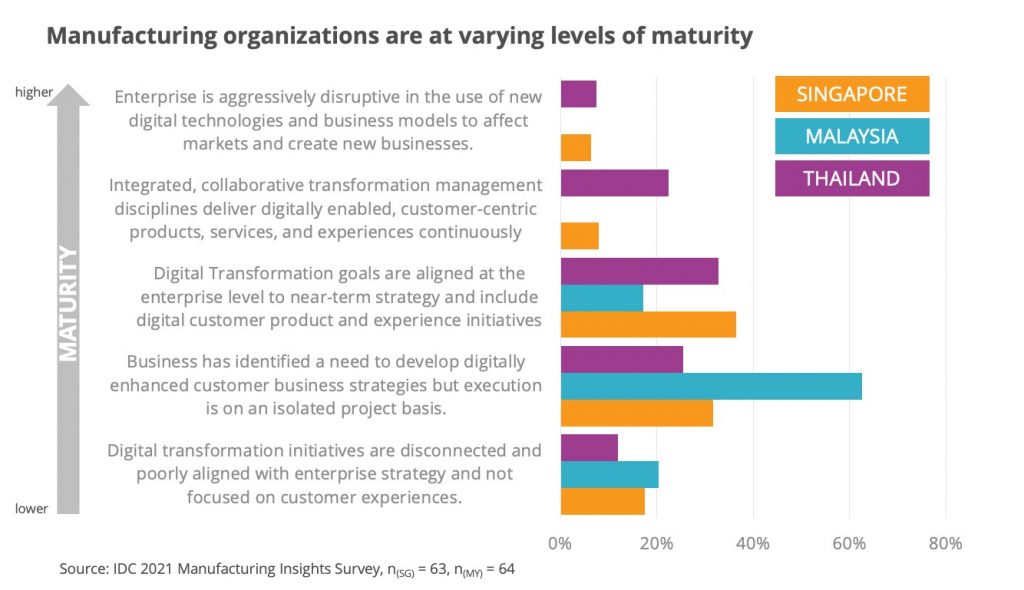This is part two of a two-part series on digital transformation for manufacturers, where we explore the real risk of not digitally transforming and the journey that manufacturers are undertaking to capitalize on the opportunity to increase revenue, profit, and operational effectiveness. You can read more in my first blog post, Are manufacturers missing out? Digital transformation reaps real benefits.
Digital transformation (what IDC calls DX) continues to dominate conversations with manufacturers about business sustainability and growth. Many organizations are reaping the benefits, and as we highlighted in the previous post, are seeing resiliency in the bottom line - DX really is profitable. However, while IDC's research shows that the number of manufacturers that have made progress in DX has grown significantly over the last three years, there is growing evidence that many organizations have reached an "impasse." In the ASEAN region, for example, 56% are still what IDC classified as "digitally distraught" and struggling with effective digital transformation.
What supports digital transformation?
We talk about four central elements to consider as part of the framework for enabling success when manufacturers embark on their digital transformation journey:
- People: Including the organizational culture and considering change management, silos of information, and the need to create a holistic view of the company to support the efficient flow of information and data-enabled decision making to drive business profitability and growth.
- Process: If manufacturers were to start their business today, would they use the same methods as 10 or 20 years ago? Being able to look at transformation as an opportunity to change the way things are done leads to more significant opportunities for improvement in quality, efficiency, innovation and profit.
- Technology: The use of technology supports the people and process and drives future business outcomes. The selection of technologies should support planned strategies to capitalize on technology investment for future use cases.
- Data: Data is a foundation to operational transformation as it supports digital innovation through autonomous, data-rich, and insight-based operations.
In advancing the organization's DX journey, these elements must be considered holistically. However, an additional dimension needs to be considered, which is the organization's digital maturity.
Why should you understand DX maturity?
Manufacturers are at varying levels of DX maturity. Figure 1 shows the maturity of manufacturing organizations in Singapore, Malaysia and Thailand. While there is a small portion of Singapore and Thai manufacturers that are advancing their maturity levels to more integrated collaborative and disruptive models, what this figure is showing is that most of the DX investment for manufacturers in Malaysia, Singapore, and Thailand will still be in the future. However, there is a limited time for manufacturers to act to ensure they do not fall behind both their local competitors and regional neighbors.

Understanding where your organization is in terms of digital maturity allows you to:
- Assess your current organizational capabilities, change management requirements, and determine how the organization needs to align to advance digitalization efforts to support the business strategy.
- Understand where you are beginning from. Knowing current strengths and limitations allows you to determine the gaps that need to be addressed to pursue digitalization efforts.
- Determine the use cases that will support your current state and plan for the future. Keep in mind that organizations can leapfrog levels of maturity to rapidly further their business growth agendas.
Sometimes we get stuck: Getting past the deadlock blues
Many companies from various industries are challenged by DX, including those that we consider being advanced, like high-tech and pharma. IDC has found five areas, or deadlocks, that typically are the source of stops or delays in this journey. These are:
- Siloed DX initiatives -- The way that transformation efforts are organized within the organization matters. Those manufacturers that are successful at DX integrate and scale initiatives across the enterprise and share responsibility for transformation beyond IT or line-of-business.
- Silos of innovation -- Digitally successful manufacturers have a holistic strategy that unites business strategy, corporate structure, culture, and transformation and uses a unified platform to drive automation, productivity gains, agility, and scale from the enterprise to the ecosystem.
- Measuring for control -- The tools manufacturers use to communicate digital success to employees, suppliers, customers, investors, and other stakeholders do not necessarily reflect how a digital enterprise operates. Metrics need to indicate real- or near-real-time financial, business, and operational requirements. Critical areas where these metrics need to be evaluated include equipment, process and service effectiveness, work and labor supply, product and service innovation rate, data capitalization, and customer loyalty and feedback.
- Overcoming limited expertise -- Most manufacturers report a lack of skills and capabilities as one of their top challenges in digital transformation (DX). It is essential to understand which competencies are necessary for your organization to succeed in the digital economy and compare current and future levels of importance to prepare for future requirements.
- Building the digital roadmap -- DX road maps help manufacturers layer use case capabilities to enable future enterprise strategy. Organizations must understand the relationship between use cases to ensure functionality is built up over time, investment is progressive, and reduces technical debt. This capabilities approach allows the creation of modular, reusable, plug-and-play and architected components with a clear priority of avoiding redundant or overlapping functionalities.
It is not unusual for manufacturers to feel that they lack proficiencies in one or more of these areas. This is where it is vital to recognize the value and role of ecosystem partners for infrastructure, software/apps, and emerging technologies. Aligning partner expertise with company capabilities and strategy will allow for the development of a more robust roadmap and increase the success of the DX journey.
If you are unsure of your company's maturity level or what deadlocks you are facing, join our second webinar and gain access to IDC's Unlock DX benchmarking tool to help make your DX journey successful:.
Register for IDC, SAS & Intel Smart Manufacturing Webcast: 4 Use Cases to Accelerate in 100 Days


